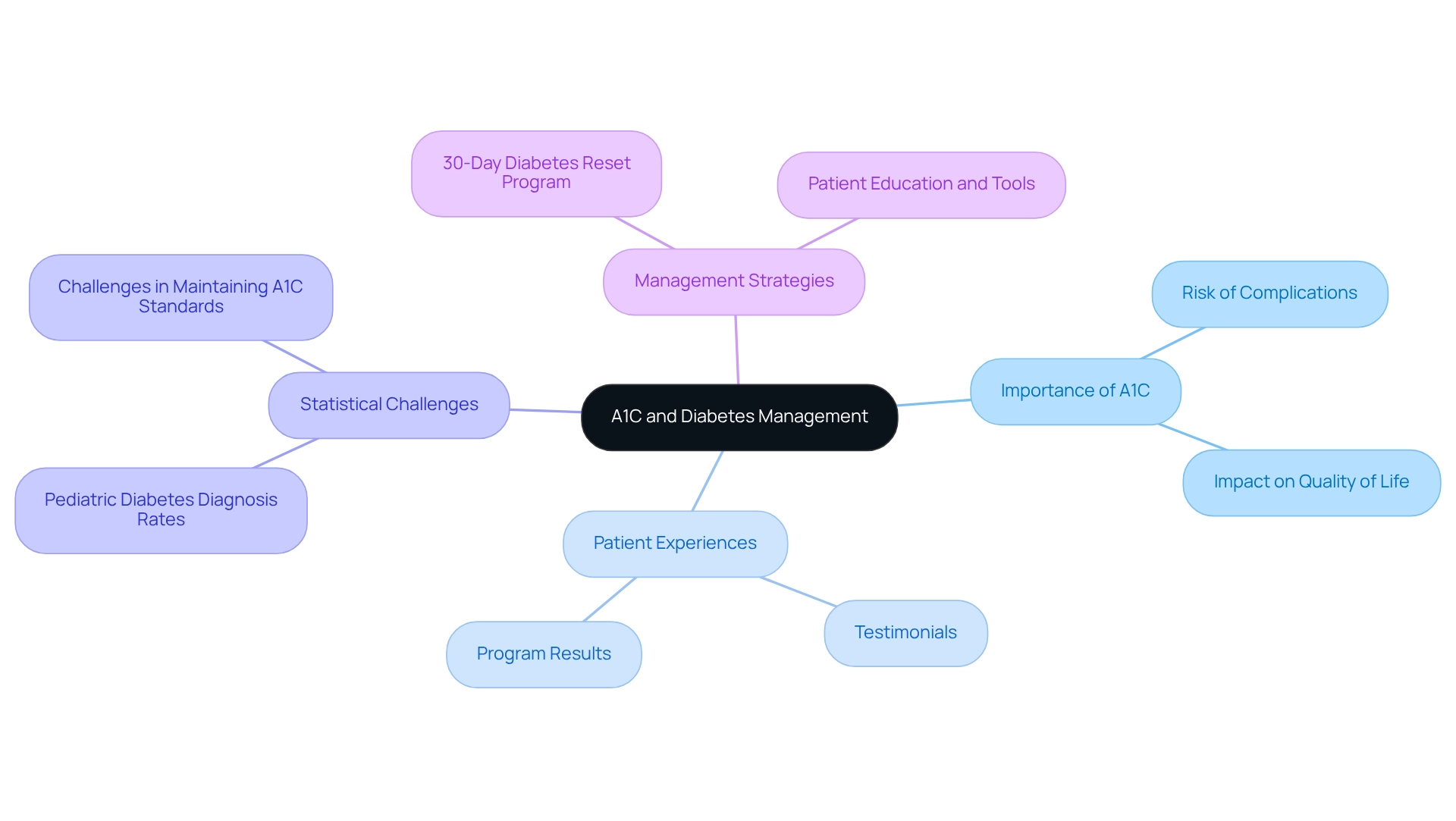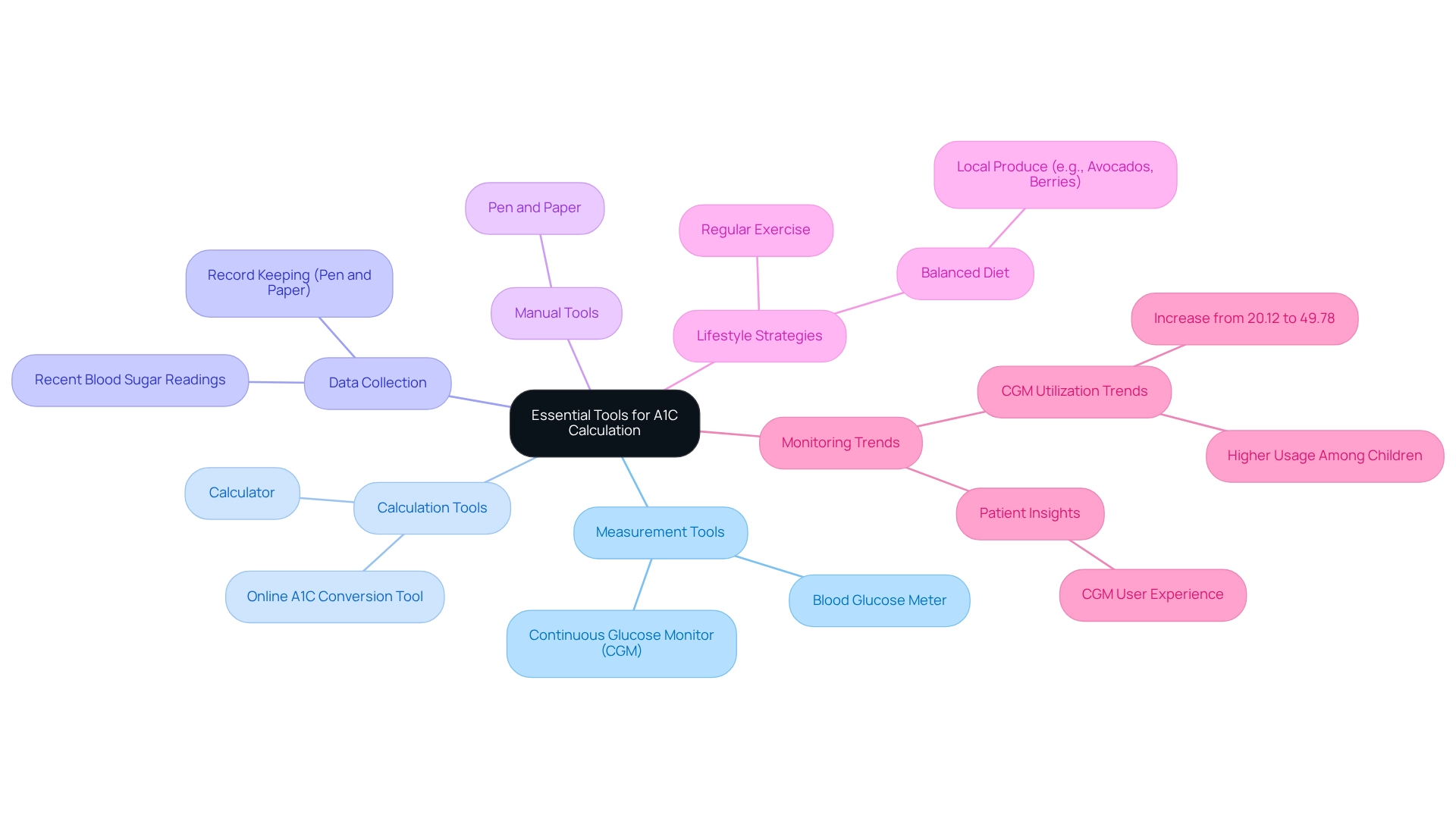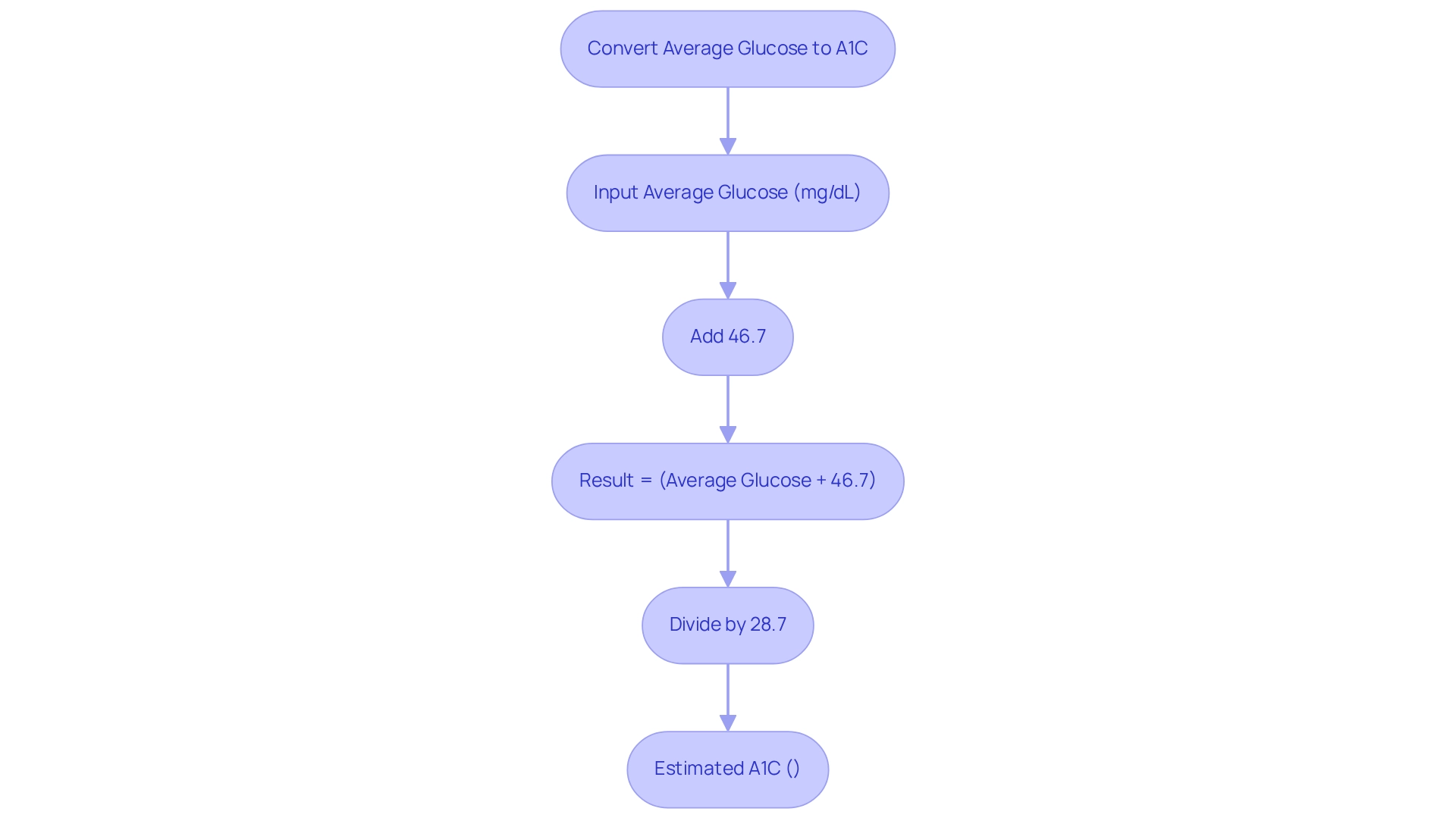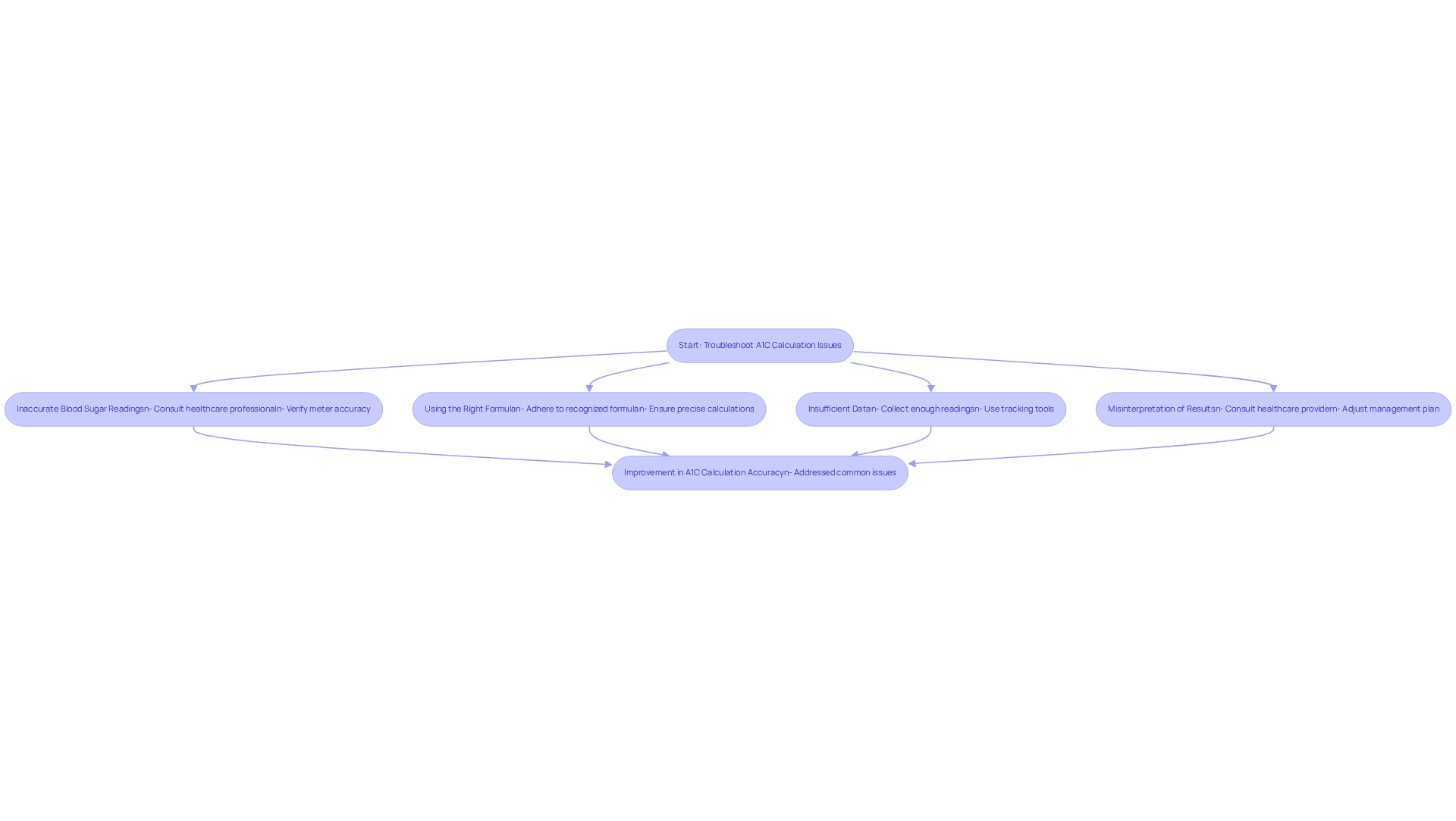Overview
Understanding how to calculate A1C from glucose can feel overwhelming, but it’s a vital step in managing your health. The formula
A1C (%) = (Average Glucose (mg/dL) + 46.7) / 28.7
helps convert your average blood sugar levels into a percentage. This percentage reflects your overall glucose control over the past two to three months, offering a clearer picture of your health journey.
It’s important to recognize that managing diabetes is not just about numbers; it’s about your well-being. This method is crucial for diabetes management, as it empowers you and your healthcare provider to assess how well your treatment is working. By understanding your A1C results, you can make informed decisions about lifestyle changes or medication adjustments, ultimately reducing the risk of complications.
Many patients find that having this knowledge brings a sense of control and hope. Remember, you are not alone in this journey. With the right support and information, you can take meaningful steps toward a healthier future.
Introduction
Understanding A1C is a pivotal aspect of diabetes management that can significantly influence your health outcomes. This critical blood test not only reflects your average blood sugar levels over the past few months but also serves as a key indicator of overall glucose control.
With the rising number of diabetes diagnoses, especially among pediatric patients in the context of COVID-19, it’s important to recognize how urgent it is to grasp the implications of A1C. As you strive to maintain optimal levels to prevent complications, innovative programs like Dr. Jason Shumard’s 30-Day Diabetes Reset are emerging, showcasing the transformative potential of personalized care.
This article delves into the intricacies of A1C, offering insights on:
- Calculation
- Troubleshooting common issues
- The importance of integrating holistic lifestyle strategies to empower you on your journey to reclaiming your health.
Understand A1C and Its Importance in Diabetes Management
A1C, or hemoglobin A1C, is an essential blood test that indicates average blood sugar levels over the prior two to three months, represented as a percentage. It’s important to recognize that elevated A1C percentages suggest inadequate blood sugar management. For those living with diabetes, targeting figures below 7% is crucial to reducing the risk of complications. Recent studies emphasize that maintaining optimal A1C levels significantly impacts treatment outcomes, with patients experiencing fewer acute and chronic complications. This can drastically influence their quality of life and mortality risk.
Many patients find that pediatric patients with COVID-19 have been observed to be 31% more likely to receive a new diagnosis of diabetes-related conditions. This highlights the urgency of effective management in light of recent health trends.
Understanding how to calculate A1C from glucose is crucial for effective management of the condition. It offers both patients and healthcare providers insights into the efficacy of treatment plans. Regular monitoring empowers patients to take charge of their health, enabling informed decisions regarding lifestyle changes and treatment adjustments. For instance, Dr. Jason Shumard’s comprehensive 30-Day Diabetes Reset program emphasizes the significance of A1C in managing the condition. Patients report transformative results through personalized care and education.
One patient shared, “I lost 55 lbs. My A1C started at 9.1 after 8 months it is now 5.7,” showcasing the program’s impact on individual health journeys. This program specifically tackles A1C readings, helping patients understand how to calculate A1C from glucose and the importance of these readings in achieving improved health results.
Current statistics indicate that a substantial segment of type 2 individuals find it challenging to uphold recommended A1C standards. Research shows that almost 50% of patients fail to achieve the target, underscoring the need for targeted interventions. Moreover, insights from endocrinologists emphasize that comprehending A1C readings is not solely about managing diabetes but also about preventing long-term health complications.
As Dr. Jason Shumard states, “By providing patients with actionable insights and practical tools, the center fosters an environment where individuals can reclaim their health and well-being.” By integrating expert insights and specific statistics, healthcare providers can create a supportive environment where individuals reclaim their health and well-being, ultimately leading to improved quality of life and reduced reliance on conventional medical interventions.
Gather Required Tools for A1C Calculation
To accurately calculate your A1C from glucose levels, you will need some essential tools that can make this process easier:
- Blood Glucose Meter: This device is crucial for measuring your blood sugar levels at various times throughout the day. Ensure that your meter is calibrated correctly and functioning optimally to obtain reliable readings.
- A simple calculator or an online A1C conversion tool can help you understand how to calculate A1C from glucose. Many diabetes associations provide these resources, simplifying the process of transforming your sugar readings into A1C values.
- Recent Blood Sugar Readings: Collect your average blood sugar readings from the past two to three months. This data is vital for knowing how to calculate A1C from glucose, as it reflects your overall glucose control during that period.
- Pen and Paper: For those who prefer manual calculations, keep a pen and paper handy to record your readings and perform calculations.
It’s important to recognize that incorporating holistic lifestyle strategies can significantly enhance your diabetes management. Embrace the outdoor lifestyle in San Marcos by utilizing local parks and trails for regular exercise, which can enhance insulin sensitivity and assist in regulating blood sugar. A balanced diet abundant in local produce, like avocados and berries, is crucial for sustaining stable sugar levels.
Many patients find that engaging with community wellness programs, such as those offered by local health organizations, can provide additional support and resources tailored to their needs, including nutrition education and fitness classes.
Current trends suggest an increasing dependence on blood sugar meters among individuals with elevated blood sugar levels. Approximately 28% of patients initiating continuous glucose monitoring (CGM) in primary care do not utilize insulin, in contrast to only 5% in endocrinology environments. This highlights the importance of effective monitoring tools in diabetes management. A study on CGM utilization trends showed that CGM usage increased from 20.12% to 49.78% between 2010-2013 and 2016-2019, indicating a significant rise in the adoption of this technology.
By 2025, advancements in blood sugar meter technology have led to more precise and user-friendly devices, enhancing the ability to monitor sugar levels effectively. For instance, the latest meters often feature Bluetooth connectivity, allowing for seamless data transfer to mobile applications, which can aid in tracking trends over time. Some effective blood sugar meters for A1C calculation include the Accu-Chek Guide and the OneTouch Verio Flex, known for their accuracy and ease of use.
When considering how to calculate A1C from glucose, it is recommended to follow best practices for using blood glucose meters. Regular calibration, proper storage of test strips, and consistent testing times can significantly improve the accuracy of your readings. Additionally, consider consulting with healthcare professionals, like Dr. Jason Shumard, for personalized recommendations on the best meters suited for your needs.
The American Diabetes Association suggests that most non-pregnant adults with the condition strive for an A1C level of less than 7% or 154 mg/dL, with individual goals differing based on personal factors.
By utilizing these tools and adhering to best practices, along with embracing a holistic approach to lifestyle changes, you can effectively manage your diabetes and gain valuable insights into your overall health. As one CGM user shared, “I woke up in the middle of the night to my CGM warning me about a severe low blood sugar. It said I was in the 40s and trending down… I was thankful my CGM alerted me and that I had my handheld blood sugar monitor close by to verify my readings.” This highlights the significance of tracking your blood sugar readings efficiently.
Apply the Formula to Convert Glucose to A1C
To convert your average blood glucose level to A1C, you can use a simple formula that many find helpful:
A1C (%) = (Average Glucose (mg/dL) + 46.7) / 28.7
For example, if your average glucose level is 150 mg/dL, you would:
- Add 46.7 to your average glucose: 150 + 46.7 = 196.7
- Divide the result by 28.7: 196.7 / 28.7 ≈ 6.86%
Thus, your estimated A1C would be approximately 6.9%. This conversion is crucial. It’s important to recognize that studies indicate a change in A1C of +1.0% corresponds to an estimated decrease in time in range (TIR) of -8.1%. For your convenience, online calculators or mobile applications can simplify this process, allowing you to enter your average blood sugar reading directly.
Understanding your A1C is essential for managing your condition effectively. It reflects your average blood sugar readings over the previous two to three months. Many individuals with type 2 blood sugar issues find that their average glucose levels can significantly affect their A1C results. By learning how to calculate A1C from glucose, you empower yourself to take control of your health and make informed choices regarding your management.
Dr. Jason Shumard emphasizes the importance of personalized care, stating, “By providing patients with actionable insights and practical tools, the center fosters an environment where individuals can reclaim their health and well-being, ultimately leading to improved quality of life and reduced reliance on conventional medical interventions.” Transformative patient experiences, like those shared by individuals who have participated in Dr. Shumard’s 30-Day Diabetes Reset program, demonstrate the effectiveness of customized approaches in managing blood sugar. Many have reported significant improvements in their health, including weight loss and reduced medication needs, showcasing the potential for holistic health solutions in reversing type 2 diabetes.
Have you considered how a supportive program like this could impact your journey? It’s never too late to take steps toward better health.
Troubleshoot Common Issues in A1C Calculation
Calculating A1C from blood sugar levels can be challenging, and it’s important to recognize the hurdles that may arise.
-
Inaccurate Blood Sugar Readings: Calibration of your blood sugar meter is crucial. If your readings seem inconsistent, it’s wise to consult a healthcare professional to verify the accuracy of your device. Research indicates that inaccuracies in blood sugar monitors (BGMs) can vary significantly. For instance, top-performing BGMs show larger absolute limits of agreement between 11% and 19%, while others can range from 19% to 43%. These discrepancies can understandably cause concern for patients.
-
Using the Right Formula: It’s essential to use the correct formula to calculate A1C from glucose. Adhering to the widely recognized formula provided in this guide can help clarify your understanding. As Kirit T. Patel, MD, points out, bedside meter measurements can sometimes provide an unreliable estimate of plasma sugar levels, which underscores the importance of precise calculations.
-
Insufficient Data: Have you collected enough blood sugar readings over the past two to three months? A limited sample size can skew your average and lead to misleading A1C results. A College of American Pathologists survey highlighted a 9.6% difference in sugar methods due to suspected calibrator inaccuracies, emphasizing the need for thorough data collection. Consistently monitoring your glucose levels through tools like fitness applications, journals, or pedometers can be beneficial. Setting SMART goals—specific, measurable, attainable, relevant, and time-bound—can also enhance your focus and motivation in managing your condition.
-
Misinterpretation of Results: A1C results can fluctuate based on individual health conditions, making it vital to consult with a healthcare provider for accurate interpretation. This collaboration can help adjust your management plan effectively, whether that means modifying medication dosages or dietary recommendations based on your specific health needs. Engaging with community wellness programs in San Marcos can provide additional support and resources tailored to your diabetes management journey.
By addressing these common issues and incorporating effective tracking strategies, you can improve the accuracy of your A1C calculations and take positive steps toward managing your diabetes.
Conclusion
Understanding A1C is fundamental to effective diabetes management, offering vital insights into average blood sugar control over the preceding months. It’s important to recognize that this pivotal blood test not only helps patients gauge their treatment efficacy but also underscores the importance of maintaining optimal A1C levels to prevent complications and enhance quality of life. Many patients find that nearly half of type 2 diabetes patients struggle to meet the recommended A1C targets, highlighting the need for targeted interventions and personalized care. Programs like Dr. Jason Shumard’s 30-Day Diabetes Reset can be essential for empowering individuals on their health journeys.
Calculating A1C from blood glucose levels can be straightforward with the right tools and knowledge. Utilizing accurate blood glucose meters and reliable conversion formulas, while maintaining a robust dataset of readings, can significantly improve the accuracy of A1C calculations. Moreover, integrating holistic lifestyle strategies, including balanced nutrition and regular exercise, fosters better overall health and diabetes management.
In light of the increasing diabetes diagnoses, particularly among pediatric populations during the COVID-19 pandemic, the urgency for effective management practices has never been more pronounced. By understanding and applying the principles of A1C monitoring and embracing personalized care approaches, individuals can reclaim their health. This journey not only reduces reliance on medical interventions but ultimately leads to healthier, more fulfilling lives. Remember, the journey to better diabetes management is not only achievable but transformative, paving the way for improved health outcomes and enhanced well-being.
Frequently Asked Questions
What is A1C and why is it important?
A1C, or hemoglobin A1C, is a blood test that indicates average blood sugar levels over the prior two to three months, represented as a percentage. Elevated A1C percentages suggest inadequate blood sugar management, making it crucial for individuals with diabetes to target figures below 7% to reduce the risk of complications.
How does A1C impact individuals with diabetes?
Maintaining optimal A1C levels significantly impacts treatment outcomes for individuals with diabetes, leading to fewer acute and chronic complications, which can drastically influence their quality of life and mortality risk.
What recent trends have been observed regarding diabetes diagnoses in pediatric patients?
Recent studies indicate that pediatric patients with COVID-19 have been observed to be 31% more likely to receive a new diagnosis of diabetes-related conditions, highlighting the urgency of effective management.
How can patients calculate A1C from glucose?
Understanding how to calculate A1C from glucose is crucial for effective management of diabetes, providing insights into the efficacy of treatment plans. Regular monitoring empowers patients to make informed decisions regarding lifestyle changes and treatment adjustments.
What is Dr. Jason Shumard’s 30-Day Diabetes Reset program?
Dr. Jason Shumard’s 30-Day Diabetes Reset program emphasizes the significance of A1C in managing diabetes, offering personalized care and education. Patients have reported transformative results, such as significant weight loss and improved A1C levels.
What challenges do type 2 diabetes patients face regarding A1C standards?
Current statistics indicate that almost 50% of type 2 diabetes patients find it challenging to uphold recommended A1C standards, underscoring the need for targeted interventions to help them achieve their health goals.
Why is understanding A1C readings important beyond diabetes management?
Comprehending A1C readings is essential not only for managing diabetes but also for preventing long-term health complications, according to insights from endocrinologists.
How can healthcare providers support patients in managing their A1C levels?
By providing actionable insights and practical tools, healthcare providers can create a supportive environment that fosters patient health and well-being, ultimately leading to improved quality of life and reduced reliance on conventional medical interventions.



